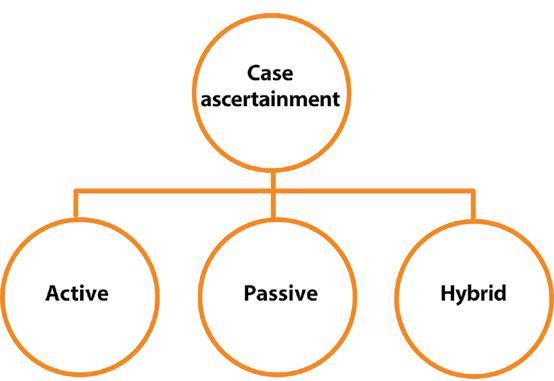3.2 Case Ascertainment
‹View Table of Contents
Once the type of population coverage has been decided, the next step is to determine how cases will be ascertained. This can be done by taking active, passive or hybrid approaches (see Fig. 3.4).
Active case ascertainment
With active case ascertainment, the surveillance personnel typically are hired and trained to conduct data abstraction (i.e. to be abstractors). Abstractors regularly visit, or have electronic access to, participating institutions (e.g. hospitals and clinics), and actively review multiple data sources (e.g. logbooks and medical, discharge and deaths records), to identify cases. Therefore, visiting all areas of the hospital where a potential fetus or neonate with a congenital anomaly can be identified could be important (e.g. a labour and delivery unit or a neonatal intensive care unit). For those fetuses or neonates identified in the logbooks as having a congenital anomaly, abstractors usually request maternal and infant medical records to abstract relevant information onto a reporting form (see Appendix G). It is noted that for this process to work well, medical records need to contain relevant information in a format that can be identified and abstracted easily by the abstractors, who usually have limited medical background.

Although this type of case ascertainment requires considerable resources and personnel, active case ascertainment tends to improve case detection and case reporting, and improves data quality because more extensive clinical details are collected.
To improve case ascertainment, the surveillance programme can link administrative databases (e.g. vital records, discharge data and insurance databases) with the surveillance programme database, to identify potential additional cases that were not ascertained from the more common sources. The identified cases will require verification by personnel going to the maternity hospitals and reviewing the medical records.
Passive case ascertainment
With passive case ascertainment, hospital personnel who identify a fetus or neonate with a congenital anomaly or anomalies report this information directly to the surveillance registry. Also, cases may be ascertained by linking administrative databases (e.g. vital records, discharge data and insurance databases) to the surveillance programme database. With passive case ascertainment, the information that is reported to the surveillance registry is typically not verified by direct abstraction of the medical record.
This type of case ascertainment is less expensive because fewer resources and personnel are required. However, the burden of reporting falls on hospitals or clinics, which might require time and effort of hospital staff who are already busy. This could result in a less than optimal reporting rate, less complete documentation or less timely reporting, or a combination thereof. It also usually yields less complete detail on each case and underestimates the number of congenital anomalies that occur. In addition, because reported information is not validated, it could also overestimate certain congenital anomalies.
Hybrid case ascertainment
Hybrid case ascertainment refers to a combination of passive case ascertainment of most types of congenital anomalies, with active case ascertainment of specific congenital anomalies, or for a percentage of all reported congenital anomalies as a quality control tool. For example, a surveillance programme can conduct active ascertainment of NTDs to gather more detailed case information in a more timely manner, but carry out passive ascertainment of all other congenital anomalies under surveillance. Similarly, a programme can use passive reporting with active follow-up verification of certain congenital anomalies.
Regardless of the method selected for case ascertainment (active or passive), each participating hospital can identify a “champion” who is committed to the programme. This could help to ensure more complete participation of the different hospital units and services participating in the surveillance programme. Also, the role of this leader could be to train other personnel (such as doctors, nurses and technicians) on how to identify cases, record the information and oversee the information flow, so as to maintain an ongoing and active quality control on the quantity and completeness of information. The role of a leader, or champion, can be important to a programme’s success.
Table of Contents
- Chapter 3: Approaches to Surveillance
- 3.1 Population Coverage
- ›3.2 Case Ascertainment
- 3.3 Case Finding
- 3.4 Case Inclusion
- 3.5 Description Formats for Congenital Anomalies
- 3.6 Age of Inclusion
- 3.7 Inclusion of Pregnancy Outcomes
- 3.8 Coding System
- 3.9 Potential Inclusion/Exclusion Criteria
- 3.10 Core Ascertainment Variables
- 3.11 Data-Collection Methods and Tools
- 3.12 Data Management and Protocols
- 3.13 Data Collection and Management